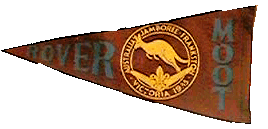
Before a gathering of 12,000 people, including many of Australia's most distinguished citizens, and in the presence of the Chief Scout of the World (Lord Baden-Powell), the Australian Jamboree was opened on Saturday by the Governor General of Australia (Sir Isaac Isaacs). It was a stirring occasion as will live forever in the memory of all who were privileged to take part.
The scene from the Vice-Regal stand was unforgettable. The long amphitheatre itself made a romantic setting. The crowd on the hillsides gave a background of vivid colouring. Beyond that again, to the left, was a sweep of blue sea mellowed by a fringe of sandy beach and green foliage toning in with a faint haze. A cool breeze, fleecy white clouds, brilliant sunshine and freshness after the early morning rain set the scene. There was no noise, no confusion, and save the busy Rovers showing visitors to their seats, there were no Scouts in sight except the 9th Malvern Troop grouped in a horseshoe formation round the flag-pole.
To the minute the Governor-General arrived; the Troop at the flag stiffened to the alert; the flag floated free, and the National Anthem sounded. For a moment or two there was a dead silence. Then the band struck up the march, and, from over the hill to the east, there arose a forest of flags. In tune with the music and stepping along proudly, the bearers of the flags of all the Nations entered the arena.

The effect was electrical. People rose in their seats and cheered. The feeling grew as the standard-bearers encircled the arena, and marching straight towards His Excellency, wheeled left and right to mass on either side of him.
Then came the Scouts. They bore themselves proudly as their Countries' emissaries. Foreign Scouts came first, and, as rank upon rank, country after country, they stepped by. Colour and beauty the scene held in plenty, but sentiment truly transfigured it. Inter-State, Lones, Victorian Counties, and Metropolitan contingents followed in endless array until the whole arena was filled. They stood as a living monument before the World Chief's eyes, of his world-work towards peace and goodwill.
For over an hour, the Governor-General took the salute as Scouts of the nations marched by. He read messages from His Majesty the King and from His Excellency the Governor-General of South Africa, and then gave his opening address.
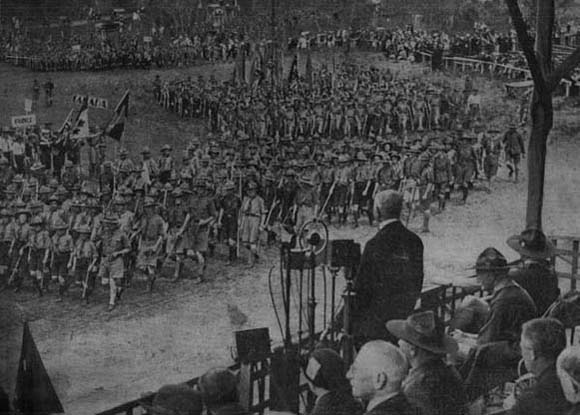
Lord Baden-Powell responded to the opening address and commanded the Scouts to put "hats on staves" to thank His Majesty the King and Sir Isaac Isaacs. Then they left as marvelously as they had come. "Left turn! Quick march!" came the order. And the whole arena, with massed flags on the far edge, moved silently, smoothly, over the hill and out of sight again. It was not a march in the ordinary sense; it was a vision.
We assembled yesterday afternoon to give thanks for our Jamboree. The sun shone. The flags of nations lifted out before a breeze. On the big hill up to the skyline and round the mounds were stretched thousands of friends come to join in triumphant hymns, humble prayers, praise.
All were assembled when a fanfare of trumpets announced the arrival of the pageant procession. As if symbolising a world-wide trust and faith, national flags came with scout flags. Then followed the dignitaries.
Immediately the last had reached their position, The State Chief Commissioner (Mr. C.A. Hoadley) stepped forward, and exhorting all to praise for the mercies of God he began the service.
40,000 people, including Scouts, attended this devotional gathering.
The atmosphere of this special evening was encapsulated by The Age:
"When the floodlights were put out the entire amphitheatre immediately became a dazzling semi-circle of thousands of electric torches, which were moved rhythmically to an fro as the vast throng sang famous Scout camp-fire songs"
During the course of the evening, Lord Baden-Powell read messages of greeting, including one from the Prince of Wales, who praised the development of the Association in Australia. He then went on to express his hope that members of the Movement would keep strong the sense of brotherhood between Scouts of different nations and that each would do his best to be a loyal citizen of the Empire.
The St. Paul's choir, under the direction of Dr. A. E. Floyd, "sang Christmas carols so beautifuly that the audience seemed inclined to defer their exit until they had rendered more carols. Generously they gave many encores, and shortly after 10 o'clock one of the finest, and certainly the greatest, of truly scouty camp fires came to a close."
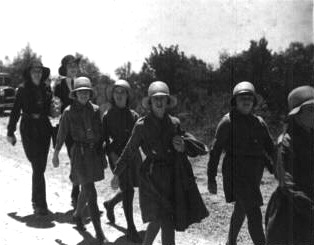
Amidst blue sky and sparkling seas, 15,000 spectators witness the Cubs and Brownies pageant. On this special day 3,000 Cubs and 1000 Brownies were to pay respect to their Chiefs. And the great arena would be filled with one colourful scene after another in a glorious spectacle of vivid sequences. Always in motion and always joyous.
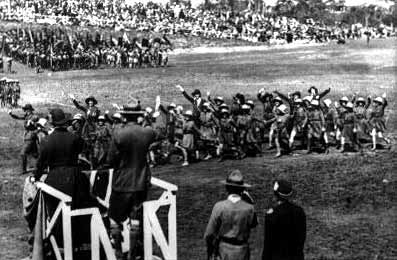
Lord and Lady Baden-Powell, the Governor and Lady Huntingfield and the Chief Commissioner of Guides, Lady Chauvel were in attendance.
January 1st was the Jamboree's biggest day. When the gates opened hundreds were waiting to enter. From then on people poured into the camp. Local buses and trains were crammed for most of the day. The stands were booked out early and there was not a vacant space in the public reserve. The Age newspaper estimates a crowd of 35,000, together with 12,000 Scouts and 8,000 Guides. On this day, the Guides and Scouts would pay tribute to their Chiefs.
Flags of the nations entered the arena amidst a storm of applause.
Then came the blue clad Guides. They marched splendidly and greeted the Chiefs in the saluting dais as they passed. The New Zealand contingent led - followed by interstate Guides and, lastly, 5,500 Victorians.
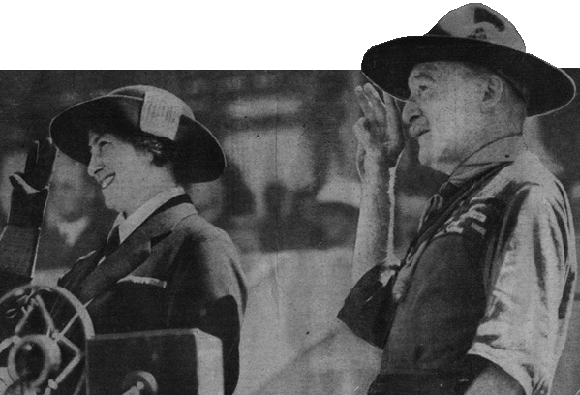
The Guides massed in front of the dais. There was no shade and the heat hung oppressively. The Chief Guide gestured to the girls: she instructed them to sit on the grass and fan themselves with hats. Nonetheless, about 200 succumbed to heat stress and fainting (The Jamboree Daily records that about 2,000 people were treated by the Rover operated first-aid station during the course of the day).
The plight of the girls was diverted by the entry of the Scouts. Line upon line of Scouts flowed onto the arena. The overseas contingents led the way. Scouts passed the saluting dais were the Chiefs took the salute. Many put "hats on staves" as a mark of respect, others cheered and smiled. The South Australians sang their state song. And so they came, contingent following contingent. Vast hordes entered the arena.
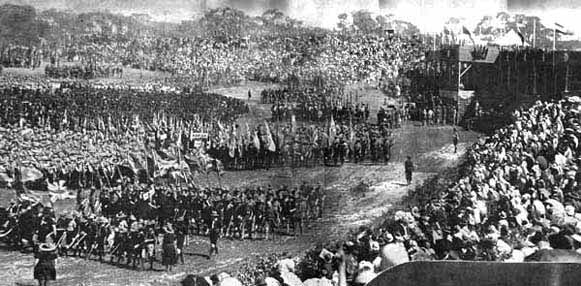
The ardour of the throng reached fever pitch; dust drowned the arena; and the blazing heat became unbearable. Urgent action was imperative: before the last 6,000 Melbourne Scouts had passed the dais, the march past was stopped.
The Chief Scout left the dais and mounted the stand to make his address. It is said that there was a burst of cheering which must have been heard far beyond Frankston.
"Scouts and Guides" said the Chief, "we have stopped the rest of the parade as it is getting pretty hot, and I am not going to detain you by making a speech. I want to wish you all a very happy New Year." He went on to say "We are here gathered together in greater numbers than has ever been the case in the world before. You boys and girls should be intent on doing your duty to your country, to your people, and to God". He then read the message from His Majesty the King, which had first been delivered by the Governor. Lord Baden-Powell then concluded his speech: "Make friends wherever you go and whenever you can; be friendly to all, and carry out the fourth Scout law. God bless you!"
When he had finished the roar of applause was deafening and a forest of hats waved on the top of staves. When the assemblage quieted, the order was given for the remaining Guides and Scouts to leave the arena. With two rows of banners flanking both sides of their ranks they left the arena and disappeared over the hill.
The Chief Guide spoke and read a message from Princess Mary, who was the Patroness of the Guides.
Lord Baden-Powell had altered the arrangements set-down in the official program. He instigated, for the afternoon, a farewell gathering in the main arena. This symbolic spectacle "pulsated with idealism and spirituality" (The Age, 7th January, 1935).
In spite of the bitterly cold and wet weather, it seemed as though every one who had, in some way or another, been involved with the Jamboree took part in this great rally.
The band struck up and, amidst tumultuous cheers, the march began. Densely massed colour parties came first, followed by the Scouts. They marched in their sub-camps, not their contingents; on this occasion, they entered the arena as one united camp of twenty-one world nations. Members of the movement gathered together in the arena. And then came a change. The formation became a human wheel, six spokes converging on the hub. A guard of honour, formed by Scouts of all nations, surrounded this central dais, and at a signal, the thousands of Scouts stood at attention.
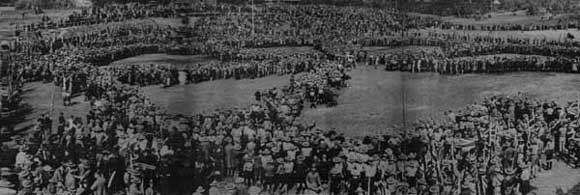
Mounting the dais, Lord Baden-Powell prepared to address the Scouts and, in response, they placed their hats on staves and thumb-sticks and cheered resoundingly. Standing at the salute and smiling, the World Chief acknowledged their greeting.
Then he articulated his enjoyment of the Jamboree. He noted, with satisfaction, that there had been a great deal of fraternisation between Scouts of different countries. Lord Baden-Powell expressed gratitude to the Scouters present and those who had worked behind the scenes to make the Jamboree a success. In mock regret, he concluded that he could not find a boy in the camp who wanted to go home!
Amidst resounding applause, the Chief Scout announced the presentation of awards. Recognition was given to those who had been instrumental in making the Jamboree a success and those who had given long service.
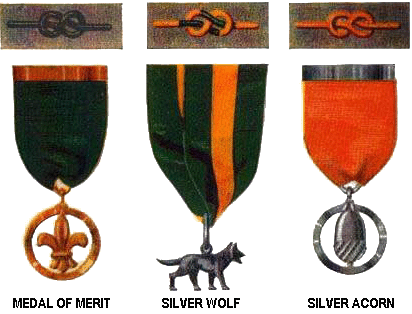
Silver Wolf awards were presented to G.W.S. Anderson (Camp Chief), W.D. Kennedy (publicity, programming and service to the Jamboree Daily), and O.H. Thomas (Quartermaster).
Many others received the "Silver Acorn", the "Medal of Merit" or a signed photograph of the World Chief Scout.
At the completion of presentations, Mr. G.H. Thomas, Chairman of the Federal Executive Council presented the Chief Scout with a blackwood writing table. Inscribed on a gold bar was the following message:
After the presentation, Lord Baden-Powell left the dais and took up his position at the hub of the wheel. He held a boomerang in his hand and spoke with emotion. The import of his speech is encapsulated in the following extracts:
"You know what a boomerang is, and its actions. If you send it out it circles round, gathering strength as it goes, and returns to you with redoubled strength. That is like love and friendship. I feel that if you send out love it returns redoubled in strength. Therefore, I have a boomerang here which I want to send round to all of you, and, through you, send love to all nations of the world."
And so, Scouts in each spoke of the ‘Wheel of Friendship’ passed the boomerang from hand to hand and were asked to remember "love of God and love of thy neighbour."
During this speech there was not a sound. At its conclusion silence was very real and significant. The boomerangs passed down the rows of bowed heads. Each contingent leader received a boomerang. As the Chief left the arena there was respectful silence. " To have cheered would have been to break the spell of a grand moment in the lives of thousands of young men banded together in a wonderful brotherhood, a brotherhood made all the more sacred by this moving ceremony during the final hours of a great experience. It was the finish of the Jamboree."
"Breathing a spirit of lofty idealism, the proceedings at the ... Rover Moot, held at the Jamboree camp were characterised by a refreshing appreciation of the obligations of man to man. This Rover Moot was the articulation of the young ideal in terms of service to others." (The Age, 13th January, 1935.)
At 3.30 p.m. on Saturday 12th January, the Rover Moot was officially opened by the World Chief. Afternoon discussions were chaired by Colonel Granville Walton, the Imperial Headquarters Commissioner for Rover Scouts.
The conference discussed the practical aspects of Scouting. Australian Rovers listened in awe to reports of social work carried out by overseas Rovers. Scouts spoke of work done in hospitals, institutions for delinquent boys, leper settlements and the slums. It became apparent that, world-wide, people appreciated the work of the movement.
In contrast to the formal discussions, the Rover Moot met at the main camp fire hollow during the evening. This event is described by The Age as being "delightfully hilarious" and the World Chief Guide, it claims, was an "entertained and entertaining participant".
Professor Sir W. Harrison Moore, speaking at the conclusion of the evening, talked about community based expectations. He said that such standards should be understood and that people should have confidence in them being upheld.
Sir Harrison Moore used the Jamboree hike as an analogy. It would have been very unsatisfactory if each hiker had been allowed to do just as he wished. Under such circumstances, the success of the event would have been doubtful. If nations in the "hike towards peace": were to do as they wished, regardless of other nations, then conflict would prevail. The League of Nations, he said, with its focal point at Geneva, endeavored to organise nations in a harmonious manner. Many nations, unfortunately, conceived the League of Nations as an organisation to further their own selfish motives.
He conveyed the belief that if such nations were part of the Scout movement, their intentions would undermine the movement's success. If the spirit of giving was instilled into the peoples of the world, then governments would be obliged to reflect their attitudes in matters of international significance.
Sir Harrison Moore suggested that peace in the world may be worked through institutions such as the Scout movement.
Sunday morning commenced with an ecumenical service. Rev. J. Danglow delivered an inspiring address in which he referred to Scouting as a shaft of light brightening the sea of life. He went on to say that Scouting stood for freedom, and that without this, the world could not be happy. The success of nations, he said, relied on the worth of the individual. Men created in the image of God lived freely and peacefully with their fellow men. That was, he said, the basic teaching of Scouting. The Movement stood for beneficent and useful action and that was what human nature required.
Sunday's program included a paper titled "The Future of a Rover", presented by Dr. T. A. Price, District Commissioner, Darling Downs, Queensland.
Proceedings were summed up by Colonel Walton and a farewell address was given by the World Chief Scout.
Lord Baden-Powell said "the work of the Rovers has been one of the reasons for the complete success of the Jamboree". The Chief Scout bade the Rovers farewell: "Go, each one of you, from here as a messenger of love and good will to others, and God speed your efforts."
